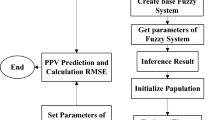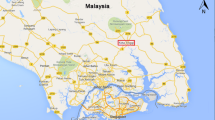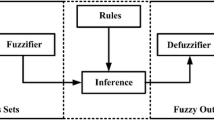Abstract
Ground vibration is one of the common environmental effects of blasting operation in mining industry, and it may cause damage to the nearby structures and the surrounding residents. So, precise estimation of blast-produced ground vibration is necessary to identify blast-safety area and also to minimize environmental effects. In this research, a hybrid of adaptive neuro-fuzzy inference system (ANFIS) optimized by particle swarm optimization (PSO) was proposed to predict blast-produced ground vibration in Pengerang granite quarry, Malaysia. For this goal, 81 blasting were investigated, and the values of peak particle velocity, distance from the blast-face and maximum charge per delay were precisely measured. To demonstrate the performance of the hybrid PSO–ANFIS, ANFIS, and United States Bureau of Mines empirical models were also developed. Comparison of the predictive models was demonstrated that the PSO–ANFIS model [with root-mean-square error (RMSE) 0.48 and coefficient of determination (R 2) of 0.984] performed better than the ANFIS with RMSE of 1.61 and R 2 of 0.965. The mentioned results prove the superiority of the newly developed PSO–ANFIS model in estimating blast-produced ground vibrations.









Similar content being viewed by others
References
Ambraseys NR, Hendron AJ (1968) Dynamic behavior of rock masses: rock mechanics in engineering practices. Wiley, London
Amiri M, Bakhshandeh Amnieh H, Hasanipanah M, Mohammad Khanli L (2016) A new combination of artificial neural network and K-nearest neighbors models to predict blast-induced ground vibration and air-overpressure. Eng Comput. doi:10.1007/s00366-016-0442-5
Barbieri R, Barbieri N, Fonseca DLK (2015) Some applications of the PSO for optimization of acoustic filters. Appl Acoust 89:62–70
Basser H et al (2015) Hybrid ANFIS–PSO approach for predicting optimum parameters of a protective spur dike. Appl Soft Comput 30:642–649
Bhandari S (1997) Engineering rock blasting operations. A. A. Balkema, Netherlands
Buragohain M (2008) Adaptive network based fuzzy inference system (ANFIS) as a tool for system identification with special emphasis on training data minimization. Ph.D. thesis, Department of electronics and communication engineering, Indian Institute of Technology Guwahati, Guwahati, 781039, India
Chiu SL (1994) Fuzzy model identification based on cluster estimation. J Intell Fuzzy Syst 2:267–278
Dadgar M, Jafari S, Hamzeh A (2015) A PSO-based multi-robot cooperation method for target search engine unknown environments. Neurocomputing. doi:10.1016/j.neucom.2015.11.007
Davies B, Farmer IW, Attewell PB (1964) Ground vibrations from shallow sub-surface blasts. Engineering 217:553–559
Dindarloo SR (2015) Prediction of blast-induced ground vibrations via genetic programming. Int J Min Sci Technol 25(6):1011–1015
Eberhart RC, Yuhui S (2000) Comparing inertia weights and constriction factors in particle swarm optimization. In: Proceedings of the 2000 congress on evolutionary computation, vol 1. IEEE
Fang KT, Lin BMT (2013) Parallel-machine scheduling to minimize tardiness penalty and power cost. Comput Ind Eng 64:224–234
Fattahi H (2016) Indirect estimation of deformation modulus of an in situ rock mass: an ANFIS model based on grid partitioning, fuzzy c-means clustering and subtractive clustering. Geosci J 20:681–690
Fattahi H, Bayatzadehfard Z (2017) A comparison of performance of several artificial intelligence methods for estimation of required rotational torque to operate horizontal directional drilling. Iran Univ Sci Technol 7:45–70
Fouladgar N, Hasanipanah M, Bakhshandeh Amnieh H (2016) Application of cuckoo search algorithm to estimate peak particle velocity in mine blasting. Eng Comput. doi:10.1007/s00366-016-0463-0
German Standards Organization (1970) Vibrations in building construction, DIN 4150
Ghasemi E, Ataei M, Hashemolhosseini H (2013) Development of a fuzzy model for predicting ground vibration caused by rock blasting in surface mining. J Vib Control 19(5):755–770
Ghomsheh VS, Aliyari Shoorehdeli M, Teshnehlab M (2007) Training ANFIS structure with modified PSO algorithm. In: Mediterranean conference on control and automation, 2007. MED’07. IEEE
Gordan B, Jahed Armaghani D, Hajihassani M, Monjezi M (2015) Prediction of seismic slope stability through combination of particle swarm optimization and neural network. Eng Comput. doi:10.1007/s00366-015-0400-7
Gupta R (2005) The recent global, developments on blasting and rock fragmentation. Tarbiat Modarres University, Tehran, pp 80–123
Hajihassani M, Jahed Armaghani D, Marto A, Tonnizam Mohamad E (2014) Ground vibration prediction in quarry blasting through an artificial neural network optimized by imperialist competitive algorithm. Bull Eng Geol Environ. doi:10.1007/s10064-014-0657-x
Hasanipanah M, Jahed Armaghani D, Khamesi H, Bakhshandeh Amnieh H, Ghoraba S (2015a) Several non-linear models in estimating air-overpressure resulting from mine blasting. Eng Comput. doi:10.1007/s00366-015-0425-y
Hasanipanah M, Monjezi M, Shahnazar A, Jahed Armaghanid D, Farazmand A (2015b) Feasibility of indirect determination of blast induced ground vibration based on support vector machine. Measurement 75:289–297
Hasanipanah M, Noorian-Bidgoli M, Jahed Armaghani D, Khamesi H (2016a) Feasibility of PSO–ANN model for predicting surface settlement caused by tunneling. Eng Comput. doi:10.1007/s00366-016-0447-0
Hasanipanah M, Shirani Faradonbeh R, Bakhshandeh Amnieh H, Jahed Armaghani D, Monjezi M (2016b) Forecasting blast induced ground vibration developing a CART model. Eng Comput. doi:10.1007/s00366-016-0475-9
Hudaverdi T (2012) Application of multivariate analysis for prediction of blast-produced ground vibrations. Soil Dyn Earthq Eng 43:300–308
Hustrulid WA (1999) Blasting principles for open pit mining: general design concepts. Balkema
Iphar M, Yavuz M, Ak H (2008) Prediction of ground vibrations resulting from the blasting operations in an open-pit mine by adaptive neurofuzzy inference system. Environ Geol 56:97–107
ISRM (1992) Suggested method for blast vibration monitoring. Int J Rock Mech Min Geol 29:145–156
ISRM (2007) In: Ulusay and Hudson (eds) The complete ISRM suggested methods for rock characterization, testing and monitoring: 1974–2006. Suggested methods prepared by the commission on testing methods, International Society for Rock Mechanics
Jahed Armaghani D, Hajihassani M, Mohamad ET, Marto A, Noorani SA (2014) Blasting-induced flyrock and ground vibration prediction through an expert artificial neural network based on particle swarm optimization. Arab J Geosci 7:5383–5396
Jahed Armaghani D, Raja SNSB, Faizi K, Rashid ASA (2015a) Developing a hybrid PSO–ANN model for estimating the ultimate bearing capacity of rock-socketed piles. Neural Comput Appl. doi:10.1007/s00521-015-2072-z
Jahed Armaghani D, Raja SNSB, Faizi K, Rashid ASA (2015b) Developing a hybrid PSO–ANN model for estimating the ultimate bearing capacity of rock-socketed piles. Neural Comput Appl. doi:10.1007/s00521-015-2072-z
Jahed Armaghani D, Tonnizam Mohamad E, Hajihassani M, Yagiz S, Motaghedi H (2015c) Application of several non-linear prediction tools for estimating uniaxial compressive strength of granitic rocks and comparison of their performances. Eng Comput. doi:10.1007/s00366-015-0410-5
Jalalifar H et al (2011) Application of the adaptive neuro-fuzzy inference system for prediction of a rock engineering classification system. Comput Geotech 38:783–790
Jang JSR (1993) ANFIS: adaptive-network-based fuzzy inference system. IEEE Trans Syst Man Cybern 23:665–685
Jang RJS, Sun CT, Mizutani E (1997) Neuro-fuzzy and soft computing. Prentice-Hall, Upper Saddle River, p 614
Jelušič P (2015) Soil compaction optimization with soft constraints. J Intell Fuzzy Syst 29:955–962. doi:10.3233/IFS-151624
Jelušič P, Žlender B (2013) Soil-nail wall stability analysis using anfis. Acta Geotech Slov 10:61–73
Jelušič P, Žlender B (2014) An adaptive network fuzzy inference system approach for site investigation. Geotech Test J 37:400–411
Kennedy J, Eberhart RC (1995) Particle swarm optimization. In: Proceedings of IEEE international conference on neural networks, Piscataway, pp 1942–1948
Khandelwal M (2011) Blast-induced ground vibration prediction using support vector machine. Eng Comput 27:193–200
Khandelwal M (2013) Correlating P-wave velocity with the physico-mechanical properties of different rocks. Pure Appl Geophys 170(4):507–514
Khandelwal M, Monjezi M (2013) Prediction of flyrock in open pit blasting operation using machine learning method. Int J Min Sci Technol 23:313–316
Khandelwal M, Ranjith PG (2010) Correlating index properties of rocks with P-wave measurements. J Appl Geophys 71(1):1–5
Khandelwal M, Singh TN (2006) Prediction of blast induced ground vibrations and frequency in opencast mine-a neural network approach. J Sound Vib 289:711–725
Khandelwal M, Singh TN (2007) Evaluation of blast-induced ground vibration predictors. Soil Dyn Earthq Eng 27:116–125
Khandelwal M, Kankar PK, Harsha SP (2010) Evaluation and prediction of blast produced ground vibration using support vector machine. Min Sci Technol (China) 20:64–70
Khandelwal M, Kumar DL, Yellishetty M (2011) Application of soft computing to predict blast-induced ground vibration. Eng Comput 27(2):117–125
Konya CJ, Walter EJ (1985) Rock blasting. United States Government Printing Office, Washington
Liang Q, An Y, Zhao L, Li D, Yan L (2011) Comparative study on calculation methods of blasting vibration velocity. Rock Mech Rock Eng 44:93–101
Mahapatra S, Daniel R, Narayan Dey D, Kumar Nayak S (2015) Induction motor control using PSO–ANFIS. Proc Comput Sci 48:754–769
Mohamadnejad M, Gholami R, Ataei M (2012) Comparison of intelligence science techniques and empirical methods for prediction of blasting vibrations. Tunn Undergr Space Technol 28:238–244
Mohamed MT (2011) Performance of fuzzy logic and artificial neural network in prediction of ground and air vibrations. Int J Rock Mech Min Sci 48:845–851
Monjezi M, Hasanipanah M, Khandelwal M (2013) Evaluation and prediction of blast-induced ground vibration at Shur River Dam, Iran, by artificial neural network. Neural Comput Appl 22:1637–1643
Palupi Rini D, Mariyam Shamsuddin S, Sophiayati Yuhaniz S (2016) Particle swarm optimization for ANFIS interpretability and accuracy. Soft Comput 20:251–262
Pousinhoa HMI, Mendesb VMF, Catalão JPS (2011) A hybrid PSO–ANFIS approach for short-term wind power prediction in Portugal. Energy Convers Manag 52:397–402
Radojica L, Kostić S, Pantović R, Vasović N (2014) Prediction of blast-produced ground motion in a copper mine. Int J Rock Mech Min Sci 69:19–25
Rai R, Singh TN (2004) A new predictor for ground vibration prediction and its comparison with other predictors. Indian J Eng Mater Sci 11(3):178–184
Shi Y, Eberhart RC (1998) A modified particle swarm optimizer. In: Proceedings of IEEE international congress on evolutionary computation, pp 69–73
Singh SP (2001) The influence of geology on blast damage. CIM Bull 94(1048):121–127
Singh TN, Singh V (2005) An intelligent approach to prediction and control ground vibration in mines. Geotech Geol Eng 23:249–262
Singh TN, Verma AK (2010) Sensitivity of total charge and maximum charge per delay on ground vibration. Geomat Nat Hazards Risk 1(3):259–272
Singh TN, Kanchan R, Verma AK (2004) Prediction of blast induced ground vibration and frequency using an artificial intelligent technique. Noise Vib Worldw 35(11):7–15
Swingler K (1996) Applying neural networks: a practical guide. Academic Press, New York
Taheri K, Hasanipanah M, Bagheri Golzar S, Abd Majid MZ (2016) A hybrid artificial bee colony algorithm-artificial neural network for forecasting the blast-produced ground vibration. Eng Comput. doi:10.1007/s00366-016-0497-3
Trivedi R, Singh TN, Gupta N (2015) Prediction of blast-induced flyrock in opencast mines using ANN and ANFIS. Geotech Geol Eng. doi:10.1007/s10706-015-9869-5
Van Den Bergh F, Engelbrecht AP (2006) A study of particle swarm optimization particle trajectories. Inf Sci 176:937–971
Verma AK, Singh TN (2011) Intelligent systems for ground vibration measurement: a comparative study. Eng Comput 27(3):225–233
Verma AK, Singh TN (2013) Comparative study of cognitive systems for ground vibration measurements. Neural Comput Appl 22:341–1643
Wiss JF, Linehan PW (1978) Control of vibration and air noise from surface coal mines. US Bureau of Mines, Report no. OFR 103
Xingjuan C, Cui Y, Tan Y (2009) Predicted modified PSO with time-varying accelerator coefficients. Int J Bio-Inspired Comput 1:50–60
Yagiz S, Gokceoglu C, Sezer E, Iplikci S (2009) Application of two non-linear prediction tools to the estimation of tunnel boring machine performance. Eng Appl Artif Intel 22(4):808–814
Zielinski K, Rainer L (2007) Stopping criteria for a constrained single-objective particle swarm optimization algorithm. Informatica (Slovenia) 31:51–59
Zlender B, Jelusicˇ P, Boumezerane D (2012) Planning geotechnical investigation using ANFIS. Geotech Geol Eng. doi:10.1007/s10706-012-9520-7
Zorlu K, Gokceoglu C, Ocakoglu F, Nefeslioglu HA, Acikalin S (2008) Prediction of uniaxial compressive strength of sandstones using petrography-based models. Eng Geol 96:141–158
Author information
Authors and Affiliations
Corresponding author
Rights and permissions
About this article
Cite this article
Shahnazar, A., Nikafshan Rad, H., Hasanipanah, M. et al. A new developed approach for the prediction of ground vibration using a hybrid PSO-optimized ANFIS-based model. Environ Earth Sci 76, 527 (2017). https://doi.org/10.1007/s12665-017-6864-6
Received:
Accepted:
Published:
DOI: https://doi.org/10.1007/s12665-017-6864-6




